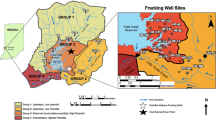Abstract
Gas shale fracturing relies on a method known as horizontal fracturing to remove gas trapped within the impermeable facies. Conventional vertical and unconventional horizontal fracturing requires a large amount of water to be injected downhole under high pressure. These fracturing fluids can contain high concentrations of petroleum hydrocarbons with known adverse health effects. The development of reuse technologies that reduce the need of potable water requires an accurate understanding of petroleum hydrocarbon loading during key points in the fracturing process. In this study, flowback water quality from both horizontally and vertically fractured wells within the Marcellus Shale region in Pennsylvania and West Virginia were analyzed. Flowback data made available by the Shale Network were collected using geographic information systems. Flowback sample analytes of interest were diesel range organic (DRO) and gasoline range organic (GRO) compounds. Noticeable patterns were present in DRO and GRO flowback data. Flowback water results showed differences between horizontally and vertically fractured well DRO patterns. Vertically fractured wells showed a sharp decrease in DRO concentrations following fracture events. Horizontally fractured wells exhibited a peak in loading when flowback water shifted to produced water. This pattern suggests the method of completion may affect DRO loading. GRO loadings appeared to not be effected by the method of completion. A horizontally fractured well and vertically fractured well within 16 km showed similar loading patterns. GRO data suggest factors such as geographic location may be responsible for VOC loading trends.












Similar content being viewed by others
References
Ames DP, Horsburgh JS, Cao Y et al (2012) HydroDesktop: web services-based software for hydrologic data discovery, download, visualization, and analysis. Environ Model Softw 37:146–156
Barbot E, Vidic NS, Gregory KB, Vidic RD (2013) Spatial and temporal correlation of water quality parameters of produced waters from Devonian-age shale following hydraulic fracturing. Environ Sci Technol 47:2562–2569. doi:10.1021/es304638h
Carothers WW (1976) Aliphatic acid anions and stable carbon isotopes of oil field waters in the San Joaquin Valley. San Jose State University
Davies R, Foulger G, Bindley A, Styles P (2013) Induced seismicity and hydraulic fracturing for the recovery of hydrocarbons. Mar Pet Geol 45:171–185
DiGiulio DC, Jackson RB (2016) Impact to underground sources of drinking water and domestic wells from production well stimulation and completion practices in the pavillion, Wyoming, Field. Environ Sci Technol. doi:10.1021/acs.est.5b04970
Fakhru’l-Razi A, Pendashteh A, Abdullah LC et al (2009) Review of technologies for oil and gas produced water treatment. J Hazard Mater 170:530–551. doi:10.1016/j.jhazmat.2009.05.044
Gorody AW (2012) Factors affecting the variability of stray gas concentration and composition in groundwater. Am Assoc Pet Geol 1:17–31. doi:10.1306/eg.12081111013
Gross SA, Avens HJ, Banducci AM et al (2013) Analysis of BTEX groundwater concentrations from surface spills associated with hydraulic fracturing operations. J Air Waste Manage Assoc 63:424–432
Hayes T (2009) Sampling and analysis of water streams associated with the development of Marcellus Shale Gas. Marcellus Shale Coalition, Des Plaines, IL
Khan NA, Engle M, Dungan B et al (2016) Volatile-organic molecular characterization of shale-oil produced water from the Permian Basin. Chemosphere 148:126–136. doi:10.1016/j.chemosphere.2015.12.116
King GE (2012) Hydraulic fracturing 101: what every representative, environmentalist, regulator, reporter, investor, university researcher, neighbor, and engineer should know about hydraulic fracturing risk. J Pet Technol 64:34–42
Lester Y, Ferrer I, Thurman EM et al (2015) Characterization of hydraulic fracturing flowback water in Colorado: implications for water treatment. Sci Total Environ 512–513:637–644. doi:10.1016/j.scitotenv.2015.01.043
Li M, Jiang B, Lin S et al (2013) Structural controls on coalbed methane reservoirs in Faer coal mine, Southwest China. J Earth Sci 24:437–448. doi:10.1007/s12583-013-0340-3
Maguire-Boyle SJ, Barron AR (2014) Organic compounds in produced waters from shale gas wells. Environ Sci Process Impacts 16:2237–2248. doi:10.1039/C4EM00376D
Thacker J, Carlton D, Hildenbrand Z et al (2015) Chemical analysis of wastewater from unconventional drilling operations. Water 7:1568–1579. doi:10.3390/w7041568
United States Energy Information Administration (2013) Annual energy outlook 2013 with projections to 2040. Department of Energy, Washington, DC
Author information
Authors and Affiliations
Corresponding author
Rights and permissions
About this article
Cite this article
Oetjen, K., Thomas, L. Volatile and semi-volatile organic compound patterns in flowback waters from fracturing sites within the Marcellus Shale. Environ Earth Sci 75, 1043 (2016). https://doi.org/10.1007/s12665-016-5847-3
Received:
Accepted:
Published:
DOI: https://doi.org/10.1007/s12665-016-5847-3




